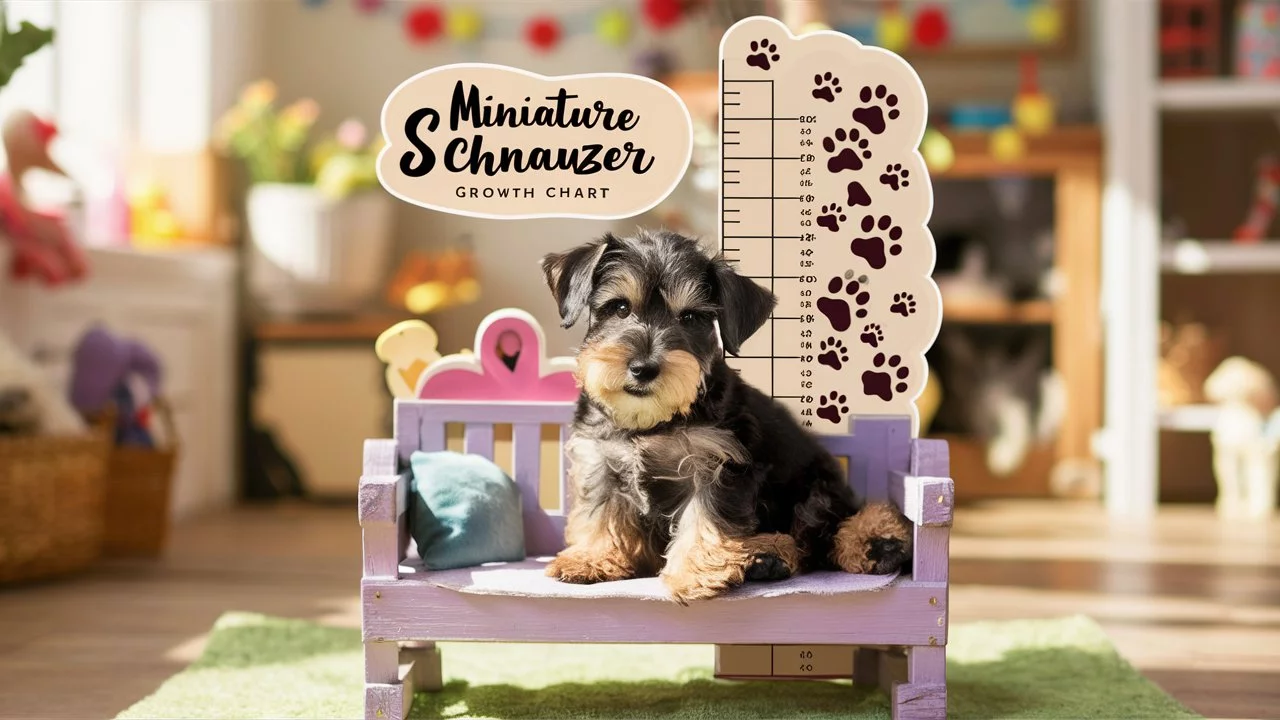Miniature Schnauzers are a beloved breed known for their intelligence, playful nature, and distinctive appearance. As a prospective or current owner, understanding their growth and development is crucial for ensuring their health and happiness.
This comprehensive guide will provide a detailed Miniature Schnauzer growth chart, insights into their growth stages, and answers to frequently asked questions.
Differences in Growth: Female vs. Male Miniature Schnauzers

When it comes to Miniature Schnauzers, one of the first things to note is the difference in growth patterns between males and females.
General Size Differences:
- Males tend to be slightly larger than females, with a more robust build.
- Females are typically more petite, weighing less and having a more slender appearance.
Growth Patterns:
- Males generally reach their full size later than females.
- Female Schnauzers often complete their growth by around 12 months, while males can continue growing until about 18 months.
Understanding these differences helps owners set realistic expectations regarding their Schnauzer’s development.
Male Miniature Schnauzer Size by Age

Tracking the size of male Miniature Schnauzers is essential for understanding their growth trajectory. Here’s a detailed overview:
| Age (Months) | Weight (lbs) | Height (inches) |
| 0-1 | 1-2 | 6-8 |
| 1-2 | 2-4 | 8-10 |
| 2-3 | 5-8 | 10-12 |
| 3-6 | 8-12 | 12-14 |
| 6-12 | 12-18 | 14-16 |
| 12-18 | 18-20 | 14-16 |
Key Takeaways:
- Males tend to have a steady growth rate in their early months, experiencing rapid growth spurts around 2-3 months.
- After six months, growth stabilizes, and owners should monitor weight to prevent obesity.
Female Miniature Schnauzer Size by Age
Female Miniature Schnauzers have their own growth patterns. Here’s a closer look:
| Age (Months) | Weight (lbs) | Height (inches) |
| 0-1 | 1-2 | 6-8 |
| 1-2 | 2-4 | 8-10 |
| 2-3 | 4-6 | 10-12 |
| 3-6 | 6-10 | 12-14 |
| 6-12 | 10-15 | 13-15 |
| 12-18 | 15-18 | 13-15 |
Key Takeaways:
- Female Schnauzers generally reach adult size faster than males, completing most of their growth by 12 months.
- Regular vet check-ups are crucial during this period to monitor growth and overall health.
Growth Stages of the Miniature Schnauzer

Understanding the various growth stages is vital for providing proper care. Here’s a detailed breakdown:
From 0 – 2 Weeks Old
During this period, Miniature Schnauzer puppies are entirely dependent on their mothers.
- Developmental Milestones:
- Eyes and ears begin to open around 10-14 days.
- Puppies will start to crawl and show slight mobility.
- Care Considerations:
- Ensure a warm and safe environment.
- Monitor the mother’s health and ensure she’s providing adequate nutrition.
From 2 – 4 Weeks Old
Puppies become more active and start to interact with their littermates.
- Socialization Tips:
- Begin introducing gentle handling to familiarize them with human contact.
- Encourage playtime to develop social skills.
- Feeding Guidelines:
- Transition from mother’s milk to a high-quality puppy formula.
From 4 – 12 Weeks Old
This stage is crucial for socialization and early training.
- Key Growth Indicators:
- Rapid physical development; puppies typically double their birth weight by 8 weeks.
- Start of teething, which may affect chewing behavior.
- Health Checks:
- Schedule vaccinations and vet visits for health monitoring.
From 3 – 6 Months Old
Puppies enter their teenage phase, exhibiting more independence.
- Behavioral Changes:
- Increased curiosity and energy levels.
- Begin basic obedience training and socialization classes.
- Dietary Needs:
- Ensure a balanced diet to support growing bones and muscles.
From 6 – 18 Months Old
As they approach adulthood, Schnauzers refine their behaviors and physical appearance.
- Transition to Adulthood:
- Growth slows, but muscle development continues.
- Males may start to show more prominent features like a broader head and thicker neck.
- Training Considerations:
- Continued training to address any behavioral issues.
- Reinforce socialization to ensure a well-adjusted adult dog.
FAQs About Miniature Schnauzer Growth and Development
How fast will my Schnauzer puppy grow, and how big will it get?
Miniature Schnauzers experience rapid growth in their first few months. Males may reach 18-20 pounds, while females typically weigh between 15-18 pounds as adults.
Is it normal for my Schnauzer puppy to have growth spurts?
Yes, growth spurts are common, especially around 3 months and 6 months. During these times, you may notice increased appetite and energy levels.
How much should I feed my growing Schnauzer puppy?
Puppy nutrition is crucial. Generally, feed a high-quality puppy food, approximately 3-4 meals a day, depending on age and size. Consult your vet for specific recommendations.
Do male and female Schnauzers grow at the same rate?
No, males typically grow larger and take longer to reach their full size compared to females.
When will my Schnauzer puppy get its adult coat?
Miniature Schnauzers usually develop their adult coat by around 12-18 months. Regular grooming is essential during this transition to maintain coat health.
How can I monitor my Schnauzer’s health during growth?
Regular vet check-ups are vital. Keep track of weight and height, and monitor behavior changes to ensure your Schnauzer remains healthy and happy.
Tips for Supporting Healthy Growth in Miniature Schnauzers
Supporting your Miniature Schnauzer’s growth involves attention to nutrition, exercise, and health care. Here are some helpful tips:
- Nutrition Recommendations:
- Choose high-quality puppy food rich in protein and essential nutrients.
- Avoid overfeeding; follow recommended serving sizes on the packaging.
- Exercise Guidelines:
- Provide regular playtime and short walks to keep them active.
- Avoid strenuous exercise until they are fully grown to prevent joint issues.
- Importance of Regular Vet Check-Ups:
- Schedule vaccinations and wellness checks.
- Discuss any concerns regarding growth or behavior with your veterinarian.
Conclusion
Tracking your Miniature Schnauzer’s growth is essential for ensuring a healthy and happy life. From understanding the differences between male and female growth patterns to recognizing the key growth stages, this guide serves as a valuable resource for current and future owners.
By staying informed and attentive to your Schnauzer’s needs, you can provide the best care possible. Always remember, regular veterinary visits and a proper diet will go a long way in supporting your furry friend’s development.
, you’ll be well-equipped to support your Miniature Schnauzer through their growth journey.












